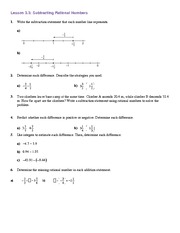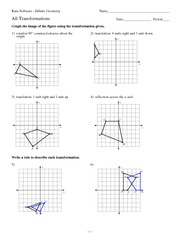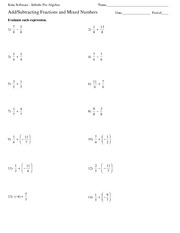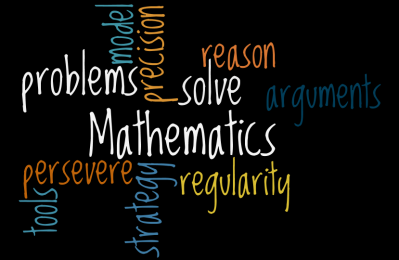Math 10/11 Honours Ch 5: Rational Functions: Assignments. 5a Non Permissible Values and Simplfying Rational Expressions. 5.1 Solving Rational Functions. 5.2 Graphing Rational Functions and Applications. 5.2b Applications of Rational Functions. 5.3 Solving Systems of Equations Involving Radicals. 5.4a Review on Solving Basic Absolute Value Equations. This is especially true in third grade, when so many new, often-complicated math theories and models come flying in from all directions. Simply put, the only way to remain a step ahead is to practice. And the best way to practice is with our third grade math worksheets. Sep 09, 2015 Mathematics 10 Learner’s Material Unit 3 1. D EPED C O PY 10 Mathematics Department of Education Republic of the Philippines This book was collaboratively developed and reviewed by educators from public and private schools, colleges, and/or universities.
In Grade 3, instructional time should focus on four critical areas: (1) developing understanding of multiplication and division and strategies for multiplication and division within 100; (2) developing understanding of fractions, especially unit fractions (fractions with numerator 1); (3) developing understanding of the structure of rectangular arrays and of area; and (4) describing and analyzing two-dimensional shapes.
- Students develop an understanding of the meanings of multiplication and division of whole numbers through activities and problems involving equal-sized groups, arrays, and area models; multiplication is finding an unknown product, and division is finding an unknown factor in these situations. For equal-sized group situations, division can require finding the unknown number of groups or the unknown group size. Students use properties of operations to calculate products of whole numbers, using increasingly sophisticated strategies based on these properties to solve multiplication and division problems involving single-digit factors. By comparing a variety of solution strategies, students learn the relationship between multiplication and division.
- Students develop an understanding of fractions, beginning with unit fractions. Students view fractions in general as being built out of unit fractions, and they use fractions along with visual fraction models to represent parts of a whole. Students understand that the size of a fractional part is relative to the size of the whole. For example, 1/2 of the paint in a small bucket could be less paint than 1/3 of the paint in a larger bucket, but 1/3 of a ribbon is longer than 1/5 of the same ribbon because when the ribbon is divided into 3 equal parts, the parts are longer than when the ribbon is divided into 5 equal parts. Students are able to use fractions to represent numbers equal to, less than, and greater than one. They solve problems that involve comparing fractions by using visual fraction models and strategies based on noticing equal numerators or denominators.
- Students recognize area as an attribute of two-dimensional regions. They measure the area of a shape by finding the total number of same-size units of area required to cover the shape without gaps or overlaps, a square with sides of unit length being the standard unit for measuring area. Students understand that rectangular arrays can be decomposed into identical rows or into identical columns. By decomposing rectangles into rectangular arrays of squares, students connect area to multiplication, and justify using multiplication to determine the area of a rectangle.
- Students describe, analyze, and compare properties of two-dimensional shapes. They compare and classify shapes by their sides and angles, and connect these with definitions of shapes. Students also relate their fraction work to geometry by expressing the area of part of a shape as a unit fraction of the whole.
Grade 3 Overview
Operations and Algebraic Thinking
- Represent and solve problems involving multiplication and division.
- Understand properties of multiplication and the relationship between multiplication and division.
- Multiply and divide within 100.
- Solve problems involving the four operations, and identify and explain patterns in arithmetic.
Number and Operations in Base Ten
- Use place value understanding and properties of operations to perform multi-digit arithmetic.
Number and Operations—Fractions
- Develop understanding of fractions as numbers.
Measurement and Data
- Solve problems involving measurement and estimation of intervals of time, liquid volumes, and masses of objects.
- Represent and interpret data.
- Geometric measurement: understand concepts of area and relate area to multiplication and to addition.
- Geometric measurement: recognize perimeter as an attribute of plane figures and distinguish between linear and area measures.
Geometry
- Reason with shapes and their attributes.
Mathematical Practices
- Make sense of problems and persevere in solving them.
- Reason abstractly and quantitatively.
- Construct viable arguments and critique the reasoning of others.
- Model with mathematics.
- Use appropriate tools strategically.
- Attend to precision.
- Look for and make use of structure.
- Look for and express regularity in repeated reasoning.
Trigonometrical ratios
SinA = $frac{{rm{p}}}{{rm{h}}}$, cosA = $frac{{rm{b}}}{{rm{h}}}$, tanA = $frac{{rm{p}}}{{rm{b}}}$, cotA = $frac{{rm{b}}}{{rm{p}}}$, SecA = $frac{{rm{h}}}{{rm{b}}}$ and cosecA = $frac{{rm{h}}}{{rm{p}}}.$
Where, p = perpendicular, b = base and h = hypotenuse and h2 = p2 + b2.
2. SinA * cosecA = 1, cosA * secA = 1, tanA * cotA = 1.

tanA = $frac{{{rm{sinA}}}}{{{rm{cosA}}}}$, cotA = $frac{{{rm{cosA}}}}{{{rm{sinA}}}}$
3. sin2A + cos2A = 1, sec2A – tan2A = 1, cosec2A – cot2A = 1
4. The trigonometric values of different degree(0° - 180°) are listed below:
Angles Ratios | Sin | Cos | Tan | Cosec | Sec | Cot |
00 | 0 | 1 | 0 | 1 | ||
300 | $frac{1}{2}$ | $frac{{sqrt 3 }}{2}$ | $frac{1}{{sqrt 3 }}$ | 2 | $frac{2}{{sqrt 3 }}$ | $sqrt 3 $ |
450 | $frac{1}{{sqrt 2 }}$ | $frac{1}{{sqrt 2 }}$ | 1 | $sqrt 2 $ | $sqrt 2 $ | 1 |
600 | $frac{{sqrt 3 }}{2}$ | $frac{1}{2}$ | $sqrt 3 $ | $frac{2}{{sqrt 3 }}$ | 2 | $frac{1}{{sqrt 3 }}$ |
900 | 1 | 0 | 1 | 0 | ||
1200 | $frac{{sqrt 3 }}{2}$ | $ - frac{1}{2}$ | $ - sqrt 3 $ | $frac{2}{{sqrt 3 }}$ | $ - 2{rm{ }}$ | $ - frac{1}{{sqrt 3 }}{rm{ }}$ |
1350 | $frac{1}{{sqrt 2 }}$ | $ - frac{1}{{sqrt 2 }}$ | -1 | $sqrt 2 $ | $ - sqrt 2 $ | -1 |
1500 | $frac{1}{2}$ | $ - frac{{sqrt 3 }}{2}$ | $ - frac{1}{{sqrt 3 }}$ | 2 | $ - frac{2}{{sqrt 3 }}$ | $ - sqrt 3 $ |
1800 | 0 | -1 | 0 | -1 |
5.With angle is (-A),
Sin(-A) = -sinA, cos(-A) = cosA. Tan(-A) = - tanA, etc.
6. When angle is (90° - A) and (90° + A)
Sin(90° - A) = cosA sin(90°+A) = cosA
Cos(90° - A) = sinA cos(90° + A) = -sinA
Math 10 Honoursmr. B. Quast's Websitemount Douglas Secondary Education


Tan(90° - A) = cotA tan(90°+A) = -cotA etc.
7. With angle (180° - A) and (180° + A)
Sin(180° - A) = sinA sin(180°+A) = -sinA
Cos(180° - A) = -cosA cos(180° + A) = -cosA
Tan(180° - A) = -tanA tan(180°+A) = tanA etc.
8. When angle is (270° - A) and (270° + A)
Sin(270° - A) = -cosA sin(270°+A) = -cosA
Cos(270° - A) = -sinA cos(270° + A) = sinA
Tan(270° - A) = cotA tan(270°+A) = -cotA etc.
9. With angle (360° - A) and (360° + A)
Math 10 Honoursmr. B. Quast's Websitemount Douglas Secondary Intention
Sin(360° - A) = -sinA sin(360°+A) = sinA
Cos(360° - A) = cosA cos(360° + A) = cosA
Tan(360° - A) = -tanA tan(360°+A) = tanA etc.
Trigonometric Ratios of compound angles:
1. sin(A + B) = sinA.cosB + cosA.sinB
2. cos(A + B) = cosA.cosB – sinA.sinB
3. Tan (A + B) = $frac{{{rm{tanA}} + {rm{tanB}}}}{{1 - {rm{tanA}}.{rm{tanB}}}}$
4. sin (A – B) = sinA.cosB - cosA.sinB
5. cos(A – B) = cosA.cosB + sinA.sinB
6. tan(A – B) = $frac{{{rm{tanA}} - {rm{tanB}}}}{{1 + {rm{tanA}}.{rm{tanB}}}}$
Trigonometric ratios of multiple angles:
1.
(i)sin2A = 2sinA.cosA
(ii)cos2A = cosA2A – sin2A = 2cos2A – 1 = 1 – 2sin2A
(iii)tan2A = $frac{{2{rm{tanA}}}}{{1 - {{tan }^2}{rm{A}}}}$
Math 10 Honoursmr. B. Quast's Websitemount Douglas Secondary School
(iv)sin2A = $frac{{2{rm{tanA}}}}{{1 + {{tan }^2}{rm{ A}}}}$
(v)cos2A = $frac{{1 - {{tan }^2}{rm{A}}}}{{1 + {{tan }^2}{rm{A}}}}$
2.
(i) sin3A = 3sinA – 4sin3A
(ii) cos3A = 4cos3A – 3cosA
(iii) tan3A = $frac{{3{rm{tanA}} - {{tan }^3}{rm{A}}}}{{1 - 3{{tan }^2}{rm{A}}}}{rm{ }}$
Trigonometric ratios of Sub-multiple angles:
1.
(i)sinA = 2sin$frac{{rm{A}}}{2}$.cos$frac{{rm{A}}}{2}$.
(ii)cosA = cosA2$frac{{rm{A}}}{2}$ – sin2$frac{{rm{A}}}{2}$. = 2cos2$frac{{rm{A}}}{2}$. – 1 = 1 – 2sin2$frac{{rm{A}}}{2}$.
(iii)tanA = $frac{{2{rm{tan}}frac{{rm{A}}}{2}.}}{{1 - {{tan }^2}frac{{rm{A}}}{2}.}}$
(iv) sinA = 3sin$frac{{rm{A}}}{3}$ – 4sin3$frac{{rm{A}}}{3}$
(v) cosA = 4cos3$frac{{rm{A}}}{3}$ – 3cos$frac{{rm{A}}}{3}$
(vi) tanA = $frac{{3{rm{tan}}frac{{rm{A}}}{3} - {{tan }^3}frac{{rm{A}}}{3}}}{{1 - 3{{tan }^2}frac{{rm{A}}}{3}}}$
Transformation of Trigonometric Formulae:
1.2sinA.cosB = sin(A + B) + sin(A – B)
2. 2cosA.sinB = sin(A+B) – sin(A – B)
3. 2cosA.cosB = cos(A + B) + cos(A – B)
4. 2sinA.sinB = cos(A + B) – cos(A + B)
5. sinC + sinD = 2sin $frac{{{rm{C}} + {rm{D}}}}{2}.$ cos $frac{{{rm{C}} - {rm{D}}}}{2}$
6. sinC – sinD = 2cos $frac{{{rm{C}} + {rm{D}}}}{2}.$ sin $frac{{{rm{C}} - {rm{D}}}}{2}$
7. cosC + cosD = 2cos $frac{{{rm{C}} + {rm{D}}}}{2}$. cos $frac{{{rm{C}} - {rm{D}}}}{2}$
8. cosC – cosD = -2sin${rm{ }}frac{{{rm{C}} + {rm{D}}}}{2}$.sin $frac{{{rm{C}} - {rm{D}}}}{2}$
Where, A = $frac{{{rm{C}} + {rm{D}}}}{2}$ and B = $frac{{{rm{C}} - {rm{D}}}}{2}$
Conditional Trigonometric Identities:
If A + B + C = π
1.sinA = sin[ π– (B + C)] = sin(B + C)
2. cosA = cos[π – (B + C)] = -cos(B + C)
3. tanA = tan[π – (B + C)] = -tan(B + C)etc.
If, $frac{{rm{A}}}{2}{rm{ }}$+ $frac{{rm{B}}}{2}$ + $frac{{rm{C}}}{2}$ = $frac{{rm{pi }}}{2}$
1.sin$frac{{rm{A}}}{2}{rm{ }}$= sin[$frac{{rm{pi }}}{2}$ – ($frac{{rm{B}}}{2}$ + $frac{{rm{C}}}{2}$)] = cos($frac{{rm{B}}}{2}$ + $frac{{rm{C}}}{2}$)
2. cos$frac{{rm{A}}}{2}{rm{ }}$ = cos[$frac{{rm{pi }}}{2}$ – ($frac{{rm{B}}}{2}$ + $frac{{rm{C}}}{2}$))] = sin($frac{{rm{B}}}{2}$ + $frac{{rm{C}}}{2}$))
3. tan$frac{{rm{A}}}{2}{rm{ }}$ = tan[$frac{{rm{pi }}}{2}$ – ($frac{{rm{B}}}{2}$ + $frac{{rm{C}}}{2}$))] = cot($frac{{rm{B}}}{2}$ + $frac{{rm{C}}}{2}$))etc.
Example 1
Prove:
cos2(A – 120°) + cos2A + cos2(A – 120°) = $frac{3}{2}$
L.H.S. = cos2(A – 120°) + cos2A + cos2(A – 120°)

= {cos2(A – 120°)}2 + cos2 A + {cos2(A + 120°)}2
= (cosA.cos120°+sinA.sin120°) + cos2A + (cosA.cos120°– sinA.sin120°)
= ${left( { - frac{1}{2}{rm{: cosA}} + frac{{sqrt 3 }}{2}{rm{sinA}}} right)^2}$+ cos2A + ${left( { - frac{1}{2}{rm{: cosA}} + frac{{sqrt 3 }}{2}{rm{sinA}}} right)^2}$
= $frac{1}{4}$cos2A – 2.$frac{1}{2}$.$frac{{sqrt 3 }}{2}$ cosA.sinA + $frac{3}{4}{rm{: }}$sin2A + cos2A + $frac{1}{4}{rm{: }}$cos2A + 2.$frac{1}{2}$.$frac{{sqrt 3 }}{2}$ cosA.sinA +$frac{3}{4}{rm{: }}$sin2A
= $frac{1}{4}$cos2 A + $frac{3}{4}$ sin2A + cos2A + $frac{1}{4}$ cos2A + $frac{3}{4}$ sin2A
= $frac{2}{4}$ cos2A + $frac{6}{4}$sin2A + cos2A.
= $frac{1}{4}$ (2cos2A + 6sin2A + 4cos2A) = $frac{1}{4}$(6cos2A + 6sin2A)
= $frac{6}{4}$(cos2A + sin2A) = $frac{3}{2}$ = R.H.S.
Example 2
If A + B+ C = π prove that cos2A + cos2B + cos2C = 1 – 2cosA.cosB.cosC
Soln:
L.H.S. =cos2A + cos2B + cos2C
= $frac{{1 + {rm{cos}}2{rm{A}}}}{2}$ + $frac{{1 + {rm{cos}}2{rm{B}}}}{2}$ + cos2C.
= $frac{1}{2} + frac{1}{2} + frac{1}{2}$ (cos2A + cos2B) + cos2C.
= 1 + $frac{1}{2}$. 2 cos $frac{{2{rm{A}} + 2{rm{B}}}}{2}$. Cos $frac{{2{rm{A}} - 2{rm{B}}}}{2}$ + cos2C.
= 1 + cos(A + B).cos(A – B) + cos2C.
= 1 – cosC.cos(A – B) + cos2C[A + B = π – C, So, cos(A+B) = cos(π – C) = – cosC]
= 1 – cosC {cos(A – B) – cosC}
= 1 – cosC {cos(A – B) + cos(A + B)}
= 1 – cosC.(cosA.cosB + sinA.sinB + cosA.cosB – sinA.sinB)
= 1 – cosC.(2cosA.cosB) = 1 – 2cosA.cosB.cosC = R.H.S.
Example 3
Solve:
2 sin2x – sinx = 0
Soln:
Here, 2 sin2x = sinx
Or, 4sinx cosx – sinx = 0
Or, sinx (4cosx – 1) = 0
Either, sinx = 0
So, x = nπ
Or, 4cosx – 1 = 0
Or, cosx = 1414
Or, cosx = cosα [cosx = 1414]
So, x = 2nπ ±± α.
So, x = 2nπ ±± cos–11414 n ԑ Z.
Height and Distance
Angle of elevation: The angle of elevation is defined as angle between the line of sight and horizontal line made by the observer when the observer observes the object above the horizontal line.
Example 4
A man observes the top of a pole 52cm height situated in front of him and finds the angle of elevation to be 30° .If the distance between man and pole is 86m .Find the height of that man.
Math 10 Honoursmr. B. Quast's Websitemount Douglas Secondary Hyperparathyroidism
Soln
Tan30° =$frac{{{rm{ED}}}}{{{rm{AD}}}}$=$frac{{{rm{ED}}}}{{86}}$
$frac{1}{{sqrt 3 }}$=$frac{{{rm{ED}}}}{{86}}$
Or, ED = $frac{{86}}{{sqrt 3 }}$
Or, ED = 49.65cm
Math 10 Honoursmr. B. Quast's Websitemount Douglas Secondary Tertiary
Height of man (DC) = EC – ED = 50- 47.65 =2.35 m
Example 5
The angle of elevation from the roof of a house to the top of atop of tree is found to be 30°. If the height of the house and tree are 8 m and 20m respectively, find the distance between the house and the tree.
Soln
ED = EC - DC = 20- 8 = 12 cm
Tan 30°=$frac{{{rm{ED}}}}{{{rm{AD}}}}$
$frac{1}{{sqrt 3 }}$=$frac{{12}}{{{rm{AD}}}}$
AD =20.78 cm
∴ Distance between tree and house is20.78 cm